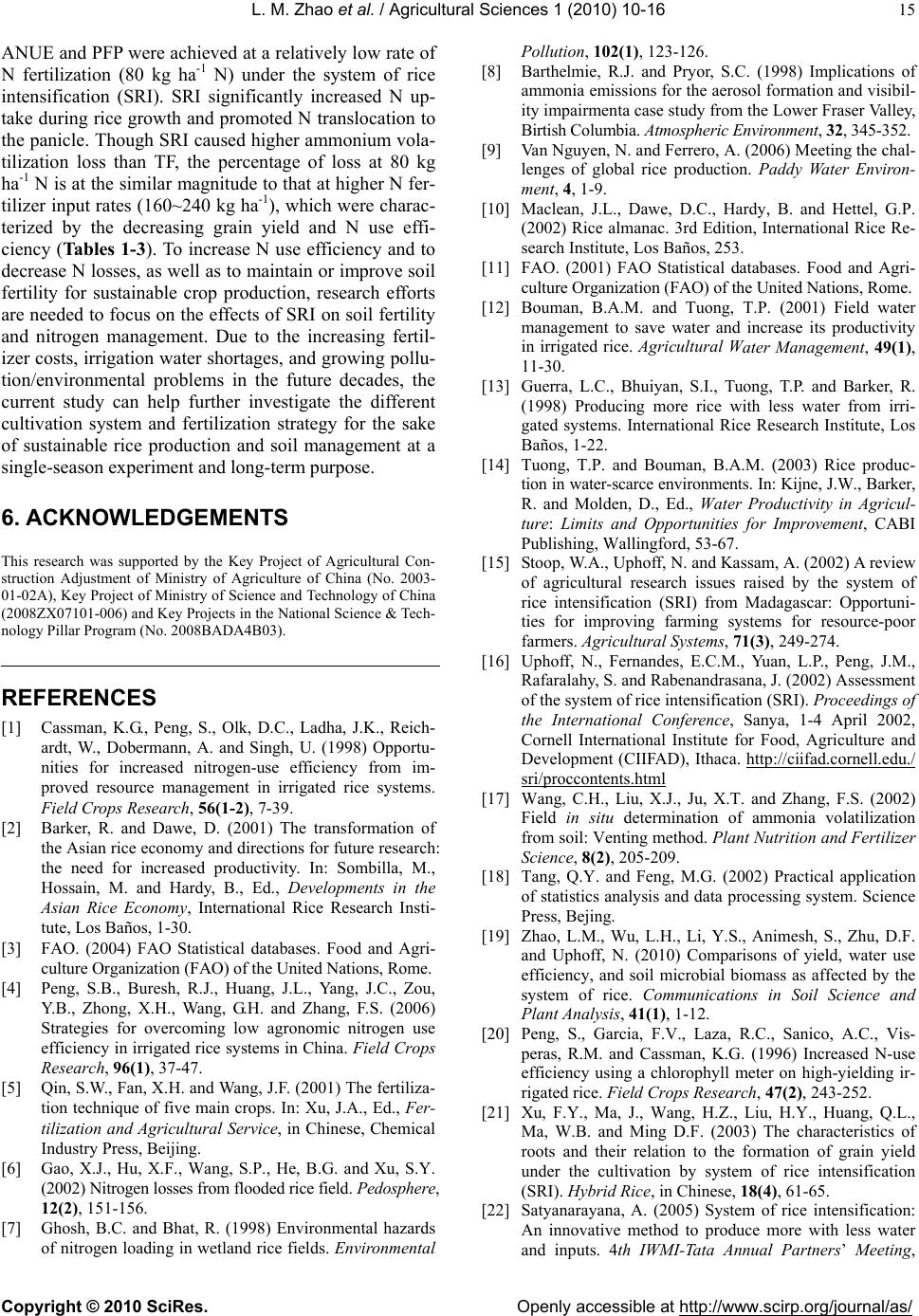
L. M. Zhao et al. / Agricultural Sciences 1 (2010) 10-16
Copyright © 2010 SciRes. Openly accessible at http://www.scirp.org/journal/as/
15
ANUE and PFP were achieved at a relatively low rate of
N fertilization (80 kg ha-1 N) under the system of rice
intensification (SRI). SRI significantly increased N up-
take during rice growth and promoted N translocation to
the panicle. Though SRI caused higher ammonium vola-
tilization loss than TF, the percentage of loss at 80 kg
ha-1 N is at the similar magnitude to that at higher N fer-
tilizer input rates (160~240 kg ha-1), which were charac-
terized by the decreasing grain yield and N use effi-
ciency (Tables 1-3). To increase N use efficiency and to
decrease N losses, as well as to maintain or improve soil
fertility for sustainable crop production, research efforts
are needed to focus on the effects of SRI on soil fertility
and nitrogen management. Due to the increasing fertil-
izer costs, irrigation water shortages, and growing pollu-
tion/environmental problems in the future decades, the
current study can help further investigate the different
cultivation system and fertilization strategy for the sake
of sustainable rice production and soil management at a
single-season experiment and long-term purpose.
6. ACKNOWLEDGEMENTS
This research was supported by the Key Project of Agricultural Con-
struction Adjustment of Ministry of Agriculture of China (No. 2003-
01-02A), Key Project of Ministry of Science and Technology of China
(2008ZX07101-006) and Key Projects in the National Science & Tech-
nology Pillar Program (No. 2008BADA4B03).
REFERENCES
[1] Cassman, K.G., Peng, S., Olk, D.C., Ladha, J.K., Reich-
ardt, W., Dobermann, A. and Singh, U. (1998) Opportu-
nities for increased nitrogen-use efficiency from im-
proved resource management in irrigated rice systems.
Field Crops Research, 56(1-2), 7-39.
[2] Barker, R. and Dawe, D. (2001) The transformation of
the Asian rice economy and directions for future research:
the need for increased productivity. In: Sombilla, M.,
Hossain, M. and Hardy, B., Ed., Developments in the
Asian Rice Economy, International Rice Research Insti-
tute, Los Baños, 1-30.
[3] FAO. (2004) FAO Statistical databases. Food and Agri-
culture Organization (FAO) of the United Nations, Rome.
[4] Peng, S.B., Buresh, R.J., Huang, J.L., Yang, J.C., Zou,
Y.B., Zhong, X.H., Wang, G.H. and Zhang, F.S. (2006)
Strategies for overcoming low agronomic nitrogen use
efficiency in irrigated rice systems in China. Field Crops
Research, 96(1), 37-47.
[5] Qin, S.W., Fan, X.H. and Wang, J.F. (2001) The fertiliza-
tion technique of five main crops. In: Xu, J.A., Ed., Fer-
tilization and Agricultural Service, in Chinese, Chemical
Industry Press, Beijing.
[6] Gao, X.J., Hu, X.F., Wang, S.P., He, B.G. and Xu, S.Y.
(2002) Nitrogen losses from flooded rice field. Pedosphere,
12(2), 151-156.
[7] Ghosh, B.C. and Bhat, R. (1998) Environmental hazards
of nitrogen loading in wetland rice fields. Environmental
Pollution, 102(1), 123-126.
[8] Barthelmie, R.J. and Pryor, S.C. (1998) Implications of
ammonia emissions for the aerosol formation and visibil-
ity impairmenta case study from the Lower Fraser Valley,
Birtish Columbia. Atmospheric Environment, 32, 345-352.
[9] Van Nguyen, N. and Ferrero, A. (2006) Meeting the chal-
lenges of global rice production. Paddy Water Environ-
ment, 4, 1-9.
[10] Maclean, J.L., Dawe, D.C., Hardy, B. and Hettel, G.P.
(2002) Rice almanac. 3rd Edition, International Rice Re-
search Institute, Los Baños, 253.
[11] FAO. (2001) FAO Statistical databases. Food and Agri-
culture Organization (FAO) of the United Nations, Rome.
[12] Bouman, B.A.M. and Tuong, T.P. (2001) Field water
management to save water and increase its productivity
in irrigated rice. Agricultural Water Management, 49(1),
11-30.
[13] Guerra, L.C., Bhuiyan, S.I., Tuong, T.P. and Barker, R.
(1998) Producing more rice with less water from irri-
gated systems. International Rice Research Institute, Los
Baños, 1-22.
[14] Tuong, T.P. and Bouman, B.A.M. (2003) Rice produc-
tion in water-scarce environments. In: Kijne, J.W., Barker,
R. and Molden, D., Ed., Water Productivity in Agricul-
ture: Limits and Opportunities for Improvement, CABI
Publishing, Wallingford, 53-67.
[15] Stoop, W.A., Uphoff, N. and Kassam, A. (2002) A review
of agricultural research issues raised by the system of
rice intensification (SRI) from Madagascar: Opportuni-
ties for improving farming systems for resource-poor
farmers. Agricultural Systems, 71(3), 249-274.
[16] Uphoff, N., Fernandes, E.C.M., Yuan, L.P., Peng, J.M.,
Rafaralahy, S. and Rabenandrasana, J. (2002) Assessment
of the system of rice intensification (SRI). Proceedings of
the International Conference, Sanya, 1-4 April 2002,
Cornell International Institute for Food, Agriculture and
Development (CIIFAD), Ithaca. http://ciifad.cornell.edu./
sri/proccontents.html
[17] Wang, C.H., Liu, X.J., Ju, X.T. and Zhang, F.S. (2002)
Field in situ determination of ammonia volatilization
from soil: Venting method. Plant Nutrition and Fertilizer
Science, 8(2), 205-209.
[18] Tang, Q.Y. and Feng, M.G. (2002) Practical application
of statistics analysis and data processing system. Science
Press, Bejing.
[19] Zhao, L.M., Wu, L.H., Li, Y.S., Animesh, S., Zhu, D.F.
and Uphoff, N. (2010) Comparisons of yield, water use
efficiency, and soil microbial biomass as affected by the
system of rice. Communications in Soil Science and
Plant Analysis, 41(1), 1-12.
[20] Peng, S., Garcia, F.V., Laza, R.C., Sanico, A.C., Vis-
peras, R.M. and Cassman, K.G. (1996) Increased N-use
efficiency using a chlorophyll meter on high-yielding ir-
rigated rice. Field Crops Research, 47(2), 243-252.
[21] Xu, F.Y., Ma, J., Wang, H.Z., Liu, H.Y., Huang, Q.L.,
Ma, W.B. and Ming D.F. (2003) The characteristics of
roots and their relation to the formation of grain yield
under the cultivation by system of rice intensification
(SRI). Hybrid Rice, in Chinese, 18(4), 61-65.
[22] Satyanarayana, A. (2005) System of rice intensification:
An innovative method to produce more with less water
and inputs. 4th IWMI-Tata Annual Partners’ Meeting,